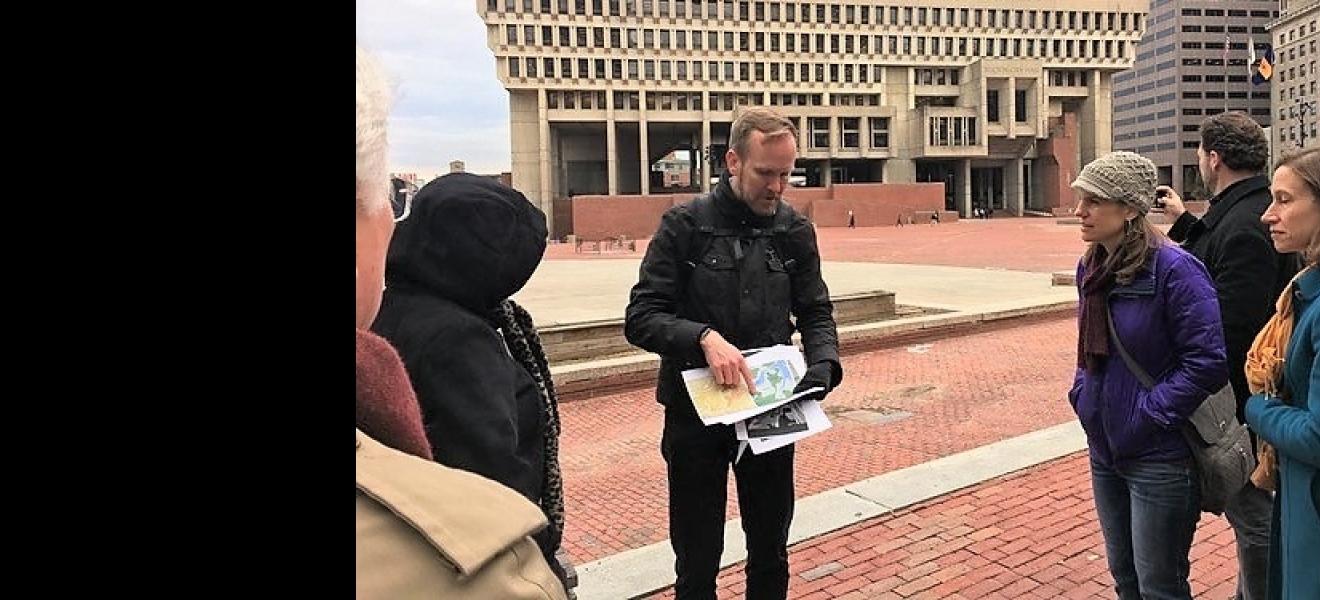Wentworth’s Mark Pasnik Remains Key Figure in Future of Boston City Hall

Wentworth Professor Mark Pasnik in Boston's Government Center
Mark Pasnik’s scholarly focus emerged 12 years ago when ArchitectureBoston Magazine asked his firm to study potential improvements to Boston City Hall, following a proposal by then-Mayor Thomas Menino for the city to sell the structure and move the seat of government elsewhere.
That plan wilted under Menino, who died in 2014. But the city’s discussion about the building and its plaza continues to this day, with Pasnik filling a couple key roles in the debate.
Pasnik’s initial study quickly grew into a series of research seminars and EPIC design studios at Wentworth Institute of Technology, in which students conducted archival research, interviewed architects, and documented the breadth of concrete buildings in Greater Boston in the 1960s and ‘70s.
The project culminated in Pasnik’s award-winning book, Heroic: Concrete Architecture and the New Boston. Published by Monacelli Press in 2015, the work put Pasnik on a path to becoming what he is today—one of the area’s leading architectural authorities on City Hall, its plaza and Boston’s modern architecture.
“We realized that Boston’s collection of concrete buildings was unusual—so many buildings of such high design quality had been built within such a short timeframe,” said Pasnik, a professor in Wentworth’s Department of Architecture.
“If cities were museums of architecture, Boston would have the foremost collection of this period in the nation.”
In subsequent years, Pasnik joined Carol Burns and Peter Greenberg, associate professors at Wentworth, for a two-year study of Paul Rudolph’s Government Service Center, in conjunction with the state agency that operates it—the Division of Capital Asset Management and Maintenance (DCAMM).
Students from the architecture and interior design programs at Wentworth played a central role in that study, while engaging with students and faculty from Boston University, Carnegie Mellon, Harvard, Northeastern, the University of Massachusetts Amherst, and Tufts. Leaders from state and municipal government, historians, preservationists, neighborhood representatives, academics, and design and engineering professionals participated.
“Wentworth’s students brought their energy and leadership skills to a real set of questions about an important but challenged government building,” Pasnik recalled. “They stepped outside the traditional classroom and learned how collaboration can enrich the value of their designs.”
The students’ findings were presented to DCAMM to help shape the agency’s understanding of the site, the building, and the issues surrounding its preservation and future development.
Along the way, Pasnik became the go-to expert on Boston’s concrete modern architecture. He is now a member of two professional teams exploring the future of Boston City Hall and its plaza, the first involving a conservation management plan sponsored by the city and the Getty Foundation. In that role, Pasnik is working with the firms Utile and Building Conservation Associates to assess the significant features of the building and develop policies to manage change.
For the second, he is working as a historical advisor for the Boston City Hall Plaza renovation led by Sasaki Associates. That project’s primary goals are to make a more accessible, connected, and sustainable plaza. These learning lessons are returning to the classroom, with Pasnik developing a new architecture studio for the fall at Wentworth grounded in the transformation of an existing building.
Details on the renovation are here: https://www.boston.gov/departments/public-facilities/city-hall-plaza-renovation and Professor Pasnik’s book is here: http://www.monacellipress.com/book/?isbn=9781580934244
--Dennis Nealon
